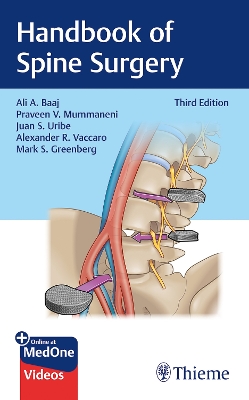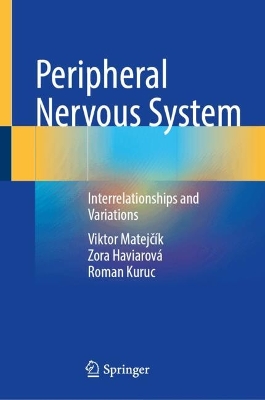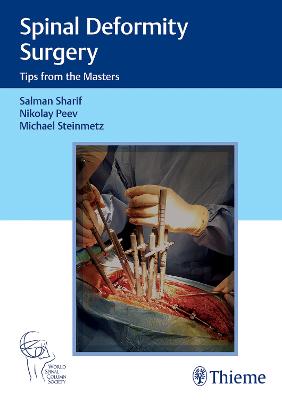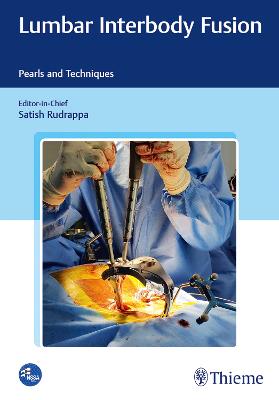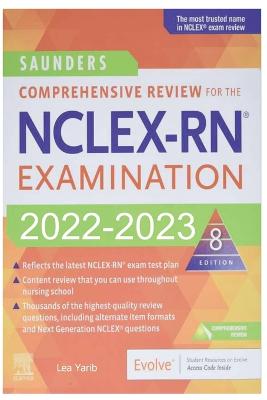Idiopathic Scoliosis
 portes grátis
portes grátis
Idiopathic Scoliosis
The Harms Study Group Treatment Guide
Newton, Peter; Shufflebarger, Harry; Harms, Juergen; Betz, Randal; Samdani, Amer
Thieme Medical Publishers Inc
11/2021
364
Dura
Inglês
9781684200559
15 a 20 dias
1361
Descrição não disponível.
Section I. Evaluation and Management
1 History of Scoliosis Treatment
2 Etiological Theories of Idiopathic Scoliosis
3 Prevalence and Natural History
4 Clinical and Radiographic Evaluation of Patients with Scoliosis
5 Nonoperative Management of Adolescent Idiopathic Scoliosis
6 Classification of Adolescent Idiopathic Scoliosis for Surgical Intervention
7 Biomechanics and Correction of Scoliosis
8 Benefits of Teams and Teamwork in Spine Surgery Quality, Safety, and Value
9 Clinical Implications of Three-Dimensional Analysis
Section II. Surgical Considerations
10 Selective versus Nonselective Fusion for Adolescent Idiopathic Scoliosis
11 Selection of Fusion Levels
12 Posterior Correction Techniques in Adolescent Idiopathic Scoliosis
13 Halo Traction in Large Idiopathic Scoliotic Curves
14 Indications and Techniques for Anterior Release and Fusion
15 Posterior Releases: Pontes and Three-Column Osteotomies
16 Surgical Treatment of the Right Thoracic Curve Pattern
17 Assessment and Management of Shoulder Balance
18 The Surgical Treatment of Lumbar and Thoracolumbar Curve Patterns (Lenke V)
19 The Surgical Treatment of Double and Triple Curves (Lenke Types 3, 4, and 6)
20 Thoracoplasty
21 Kyphosis Restoration in Adolescent Idiopathic Scoliosis
Section III. Postoperative Management
22 Long-Term Clinical and Radiographic Outcomes of Scoliosis
23 Infection in Adolescent Idiopathic Scoliosis
24 Complications and Reoperations in Adolescent Idiopathic Scoliosis
25 Accelerated Pathways
26 Untreated Late-Onset Idiopathic Scoliosis and Revision Surgery in Adults
Section IV. Miscellaneous Topics
27 Osteobiologic Agents for Spinal Fusion
28 Intraoperative Neuromonitoring
29 Anterior Growth Modulation
30 Managing the Preadolescent Curve: Early Fusion versus Posterior Distraction
31 The Development and Evolution of the Harms Study Group Registry
1 History of Scoliosis Treatment
2 Etiological Theories of Idiopathic Scoliosis
3 Prevalence and Natural History
4 Clinical and Radiographic Evaluation of Patients with Scoliosis
5 Nonoperative Management of Adolescent Idiopathic Scoliosis
6 Classification of Adolescent Idiopathic Scoliosis for Surgical Intervention
7 Biomechanics and Correction of Scoliosis
8 Benefits of Teams and Teamwork in Spine Surgery Quality, Safety, and Value
9 Clinical Implications of Three-Dimensional Analysis
Section II. Surgical Considerations
10 Selective versus Nonselective Fusion for Adolescent Idiopathic Scoliosis
11 Selection of Fusion Levels
12 Posterior Correction Techniques in Adolescent Idiopathic Scoliosis
13 Halo Traction in Large Idiopathic Scoliotic Curves
14 Indications and Techniques for Anterior Release and Fusion
15 Posterior Releases: Pontes and Three-Column Osteotomies
16 Surgical Treatment of the Right Thoracic Curve Pattern
17 Assessment and Management of Shoulder Balance
18 The Surgical Treatment of Lumbar and Thoracolumbar Curve Patterns (Lenke V)
19 The Surgical Treatment of Double and Triple Curves (Lenke Types 3, 4, and 6)
20 Thoracoplasty
21 Kyphosis Restoration in Adolescent Idiopathic Scoliosis
Section III. Postoperative Management
22 Long-Term Clinical and Radiographic Outcomes of Scoliosis
23 Infection in Adolescent Idiopathic Scoliosis
24 Complications and Reoperations in Adolescent Idiopathic Scoliosis
25 Accelerated Pathways
26 Untreated Late-Onset Idiopathic Scoliosis and Revision Surgery in Adults
Section IV. Miscellaneous Topics
27 Osteobiologic Agents for Spinal Fusion
28 Intraoperative Neuromonitoring
29 Anterior Growth Modulation
30 Managing the Preadolescent Curve: Early Fusion versus Posterior Distraction
31 The Development and Evolution of the Harms Study Group Registry
Este título pertence ao(s) assunto(s) indicados(s). Para ver outros títulos clique no assunto desejado.
adolescent spine disorders; back disorder; curvature of spine; scoliosis; spine deformities; surgery; treatment
Section I. Evaluation and Management
1 History of Scoliosis Treatment
2 Etiological Theories of Idiopathic Scoliosis
3 Prevalence and Natural History
4 Clinical and Radiographic Evaluation of Patients with Scoliosis
5 Nonoperative Management of Adolescent Idiopathic Scoliosis
6 Classification of Adolescent Idiopathic Scoliosis for Surgical Intervention
7 Biomechanics and Correction of Scoliosis
8 Benefits of Teams and Teamwork in Spine Surgery Quality, Safety, and Value
9 Clinical Implications of Three-Dimensional Analysis
Section II. Surgical Considerations
10 Selective versus Nonselective Fusion for Adolescent Idiopathic Scoliosis
11 Selection of Fusion Levels
12 Posterior Correction Techniques in Adolescent Idiopathic Scoliosis
13 Halo Traction in Large Idiopathic Scoliotic Curves
14 Indications and Techniques for Anterior Release and Fusion
15 Posterior Releases: Pontes and Three-Column Osteotomies
16 Surgical Treatment of the Right Thoracic Curve Pattern
17 Assessment and Management of Shoulder Balance
18 The Surgical Treatment of Lumbar and Thoracolumbar Curve Patterns (Lenke V)
19 The Surgical Treatment of Double and Triple Curves (Lenke Types 3, 4, and 6)
20 Thoracoplasty
21 Kyphosis Restoration in Adolescent Idiopathic Scoliosis
Section III. Postoperative Management
22 Long-Term Clinical and Radiographic Outcomes of Scoliosis
23 Infection in Adolescent Idiopathic Scoliosis
24 Complications and Reoperations in Adolescent Idiopathic Scoliosis
25 Accelerated Pathways
26 Untreated Late-Onset Idiopathic Scoliosis and Revision Surgery in Adults
Section IV. Miscellaneous Topics
27 Osteobiologic Agents for Spinal Fusion
28 Intraoperative Neuromonitoring
29 Anterior Growth Modulation
30 Managing the Preadolescent Curve: Early Fusion versus Posterior Distraction
31 The Development and Evolution of the Harms Study Group Registry
1 History of Scoliosis Treatment
2 Etiological Theories of Idiopathic Scoliosis
3 Prevalence and Natural History
4 Clinical and Radiographic Evaluation of Patients with Scoliosis
5 Nonoperative Management of Adolescent Idiopathic Scoliosis
6 Classification of Adolescent Idiopathic Scoliosis for Surgical Intervention
7 Biomechanics and Correction of Scoliosis
8 Benefits of Teams and Teamwork in Spine Surgery Quality, Safety, and Value
9 Clinical Implications of Three-Dimensional Analysis
Section II. Surgical Considerations
10 Selective versus Nonselective Fusion for Adolescent Idiopathic Scoliosis
11 Selection of Fusion Levels
12 Posterior Correction Techniques in Adolescent Idiopathic Scoliosis
13 Halo Traction in Large Idiopathic Scoliotic Curves
14 Indications and Techniques for Anterior Release and Fusion
15 Posterior Releases: Pontes and Three-Column Osteotomies
16 Surgical Treatment of the Right Thoracic Curve Pattern
17 Assessment and Management of Shoulder Balance
18 The Surgical Treatment of Lumbar and Thoracolumbar Curve Patterns (Lenke V)
19 The Surgical Treatment of Double and Triple Curves (Lenke Types 3, 4, and 6)
20 Thoracoplasty
21 Kyphosis Restoration in Adolescent Idiopathic Scoliosis
Section III. Postoperative Management
22 Long-Term Clinical and Radiographic Outcomes of Scoliosis
23 Infection in Adolescent Idiopathic Scoliosis
24 Complications and Reoperations in Adolescent Idiopathic Scoliosis
25 Accelerated Pathways
26 Untreated Late-Onset Idiopathic Scoliosis and Revision Surgery in Adults
Section IV. Miscellaneous Topics
27 Osteobiologic Agents for Spinal Fusion
28 Intraoperative Neuromonitoring
29 Anterior Growth Modulation
30 Managing the Preadolescent Curve: Early Fusion versus Posterior Distraction
31 The Development and Evolution of the Harms Study Group Registry
Este título pertence ao(s) assunto(s) indicados(s). Para ver outros títulos clique no assunto desejado.

